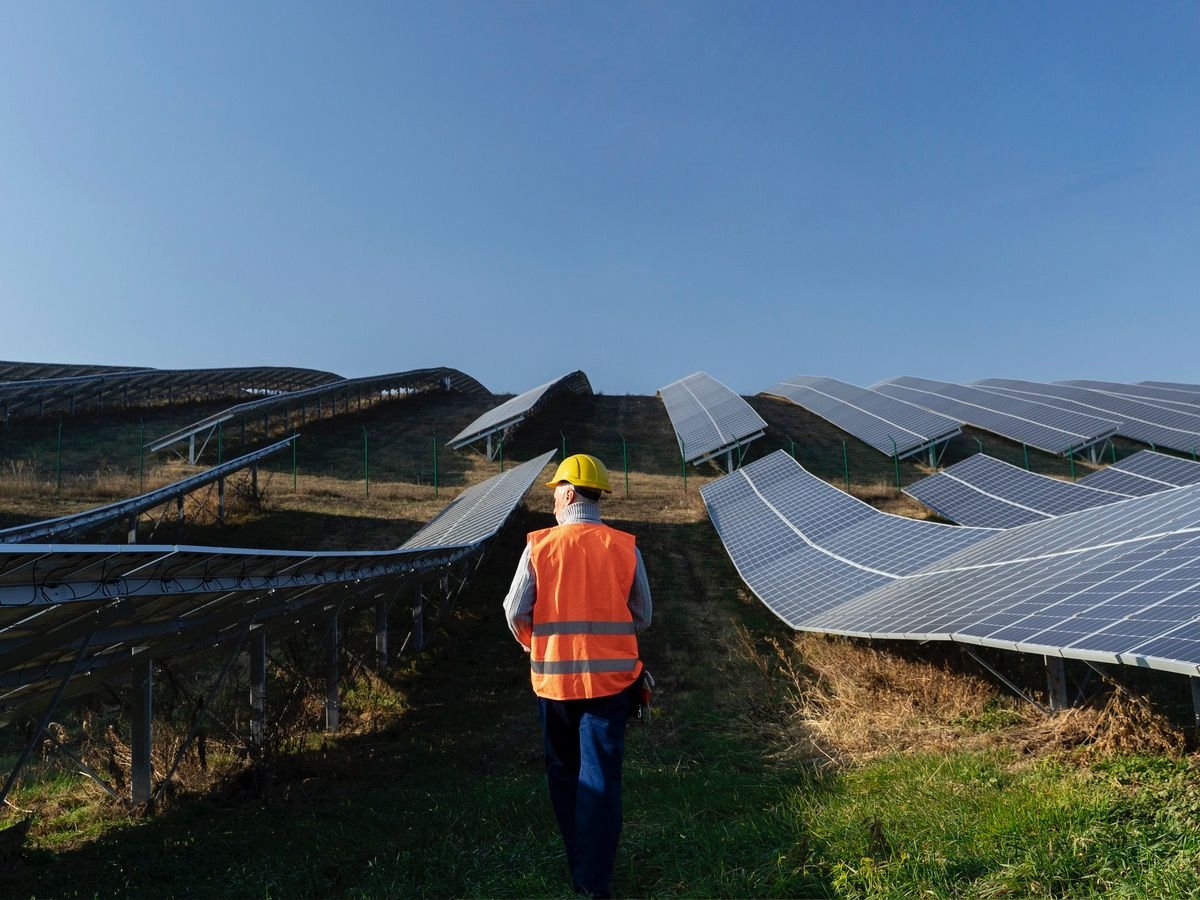Generating solar power in the Middle East may seem a piece of cake, but the truth is that harsh weather conditions can make solar plants extremely volatile.
Very high temperatures and proximity to deserts may pose a serious threat to solar power plants and PV modules – due to sand and dust. The consequences of soiling accumulation may truly be grave and include significant power losses.
Wind power and smart solar farm management depend greatly on the region. Some areas, e.g., ones in northern Africa that are close to deserts, are way more demanding than those that are not that dry and hot. And due to climate change, things will probably get even worse. For instance, the Sahara is getting bigger steadily – it has already grown by 10% since 1920.
In such circumstances, efforts to maintain high efficiency for power generation are something vital. And what can save the day – and a lot of time and money – is using ongoing automation systems. They help maintain the PV infrastructure in pristine condition, e.g., by providing constant, real-time supervision and enabling measuring, forecasting, and analyzing various types of data.
Table of contents:
1. Solar and wind power in brief
2. How harsh weather can affect solar panels
3. Green energy revolution in the Middle East
4. Solution: ongoing automation systems
5. Solar power in hot climate – key takeaways
Solar and wind power in brief
Solar power is all about converting energy from sunlight into electricity. This can be made, e.g., by using photovoltaic (PV) technology that converts sunlight energy into electric power, or by using concentrated solar power. Both ways can be used for large-scale energy production.
Concentrated solar power (or CSP) uses solar light that is concentrated with mirrors or lenses for electricity generation. Heat engines or thermochemical reactions are in use in this case, and CSP can be called a thermal energy-generating power station.
CSP is a promising technology, with a notable interest in North Africa and the Middle East. Overall, it is still way less popular than PV systems due to high costs and being more technically complicated. However, it has the advantage of making storing energy at night easier.
Wind power is based on wind turbines that harness the energy from the wind. Wind’s kinetic energy is transformed into electricity. As of 2023, there are over 26,000 wind farms globally as well as 227 turbine manufacturers, but the interest in the Middle East is still rather moderate.
How harsh weather can affect solar panels
Snowstorms may seem harmful for solar panels, but research and tests proved that snow is (usually) not a big issue for them and does not affect power generation significantly. That’s because solar panels have smooth glass surfaces and steep angles, and the snow on solar panels is being blown off by the wind quickly. What’s more, snow can even help clean PV modules as it melts away.
Interestingly, solar panels work better in cold conditions, so cold and sunny days are ones when they are effective. They work best between 15°C and 35°C, and when the temperature rises high, they tend to perform worse – with extremely hot temperatures slashing their output efficiency even by 25%.
But there’s something that’s even worse – PV soiling. It means the accumulation of dirt, dust, and other contaminants on light-collecting surfaces of PV panels. Proximity to deserts is the key factor when it comes to soiling risk; others are the vicinity of roads, industrial plants, agricultural infrastructure, etc. Soiling is very important as the deposition of airborne particles can even block the light completely in the worst-case circumstances.
This scenario may seem to be a bit far-fetched but the facts are that the accumulation of dust can lead to a decrease in the efficiency of PV modules of as much as 66%! That was the case after six months without panel cleaning – research conducted in Egypt proved. Worldwide, PV soiling losses are immense and estimated to exceed $3.2 billion per year.
The solar energy-related soiling that leads to a loss in power output is usually made of things like pollen, lichen, fungi, soot, moss, engine exhaust, falling leaves, bird droppings, biofilm of bacteria, ice, snow, and, most importantly, mineral dust.
Mineral dust aerosols may contain silt, silica, salts, and clay particles – their color and composition depend on the region. Airborne dust is definitely a major problem in the Middle East – as the main source of mineral dust is the Sahara Desert.
Green energy revolution in the Middle East
The Middle East turns to clean energy, and the number and worth of investments are on the sharp rise. For example, one of the largest solar power plants – Benban – is located in Egypt. But it’s not only about solar power; wind farms – in countries like Egypt, Oman, and Saudi Arabia – are slowly gaining momentum, too.
Many countries in the Middle East region have developed their own sustainable energy strategies. The targets are often very ambitious – e.g., Saudi Arabia wants 50% of electricity in the country to come from renewables by 2030.
However, the Middle East renewable energy involves many challenges, with dust storms and extreme heat waves topping the list. And dust's side effects are mind-blowing, indeed. For example, in Saudi Arabia, three days without wiping was enough for heat collection to drop by 30% in solar collectors.
Desert solar farm maintenance is a demanding task and using proper automated cleaning systems is vital when there’s a lot of dust in the air and sandstorms are common. People who live in or near deserts and have medium-sized or large solar plants are already well aware that cleaning PV infrastructure regularly is simply a must.
Solution: ongoing automation systems
To ensure long-lasting PV efficiency and mitigate soiling loss, a soiling monitoring system and appropriate PV cleaning automation solutions need to be implemented. Choosing the right cleaning technology is vital in this regard.
The right cleaning technique depends on the region and the local weather conditions. For example, in the areas that are „hot, arid, sunny”, as well as „dry”, sprinklers, autonomous/automated cleaning, and electrostatic biasing are the optimal proposed solutions.
Water-saving and time-efficient, fully- or semi-automatic systems with automated drones and portable robots are available on the market. Electrodynamic cleaning systems that wipe dust particles from PV modules with traveling waves are another interesting idea to consider.
What also helps mitigate soiling are:
- anti-soiling coatings,
- dew mitigation solutions,
- sing vertical bifacial modules facing east-west and frameless ones,
- as well as flipping monofacial modules upside down during the non-sunshine hours.
Due to the harsh weather, the best option to maintain high efficiency for power generation is an ongoing automation system. Manual cleaning is not that efficient but is time-consuming, costly, and – potentially – harmful to the dusted surface.
Solar power in hot climate – key takeaways
Solar power systems that include solar panels and solar cells are the future of energy production. However, high solar radiation, typical of the Middle East region, is not enough for them to succeed. That’s because ubiquitous dust particles can form dust deposits quickly, totally blocking or scattering sunlight.
When uncleaned, airborne dust concentration can lead to significant power losses. That’s why dust removal with ongoing automation systems is very important. As is keeping PV infrastructure well-maintained in every other aspect, including dust and sandstorm protection.
Solar and wind energy generation may seem to be an easy, universal solution, but the local environment in which it is implemented is crucial. There are many specific factors and conditions – including wind speed, dust, dirt, temperature, sand, rain, and pollution – that can either make it or break it.
However, it’s good to remember that extremely high temperatures and heatwaves are more and more common in Europe, too. And that the dust from the Sahara can reach not only the Middle East but go way beyond that, causing serious losses in PV systems elsewhere.
Want to make the most of solar energy materials and avoid any possible drawbacks and constraints? If you’d like your solar collectors and PV panels clean, operable, and highly efficient, contact Codete now – let's talk about our anti-soiling management software solutions >>



